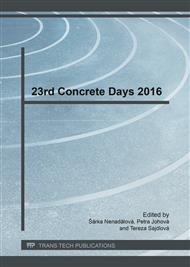[1]
Lee, G.; Han, D., Han, M., Han, Ch., Son, H. Combining polypropylene and nylon fibers to optimize fiber addition for spalling protection of high-strength concrete., Construction and Building Materials 34, 2012: 313-320.
DOI: 10.1016/j.conbuildmat.2012.02.015
Google Scholar
[2]
Neto, A. B., & Rovere, H. L. Composite concrete/GFRP slabs for footbridge deck systems. Composite Structures 92 , 2010, p.2554–2564.
DOI: 10.1016/j.compstruct.2010.02.005
Google Scholar
[3]
Mendes, P. J., Barros, J. A., Sena-Cruz, J. M., & Taheri, M. Development of a pedestrian bridge with GFRP profiles and fiber reinforced self-compacting concrete deck. Composite Structures 93 , 2010, p.2969–2982.
DOI: 10.1016/j.compstruct.2011.05.005
Google Scholar
[4]
Gonilha, J. A., Correia, J. R., Branco, F. A., Caetano, E., & Cunha, Á. Modal identification of a GFRP-concrete hybrid footbridge prototype: Experimental tests and analytical and numerical simulations. Composite Structures 106 , 2013, pp.724-733.
DOI: 10.1016/j.compstruct.2013.07.003
Google Scholar
[5]
Figueiredo, A. D., Fuente, A. d., Aguado, A., Molins, C., & Neto, P. J. Steel fiber reinforced concrete pipes: part 1: technological analysis of the mechanical behavior. Ibracon Structures and Materials Journal , February 2012, pp.1-11.
DOI: 10.1590/s1983-41952012000100002
Google Scholar
[6]
Mohamed, N., Soliman, A. M., & Nehdi, M. L. Mechanical performance of full-scale precast steel fibre-reinforced concrete pipes. Engineering Structures 84 , 2015, pp.287-299.
DOI: 10.1016/j.engstruct.2014.11.033
Google Scholar
[7]
Fuente, A. d., Escariz, R. C., Figueiredo, A. D., & Aguado, A. Design of macro-synthetic fibrereinforced concrete pipes. Construction and Building Materials 43, 2013, pp.523-532.
DOI: 10.1016/j.conbuildmat.2013.02.036
Google Scholar
[8]
Gholamhoseini, A., Khanlou, A., MacRae, G., Scott, A., Hicks, S., & Leon, R. An Experimental Study on Strength and Serviceability of Reinforced and Steel Fibre Reinforced Concrete (SFRC) Continuous Composite Slabs. Engineering Structures (114) , 2016, pp.171-180.
DOI: 10.1016/j.engstruct.2016.02.010
Google Scholar
[9]
Abas, F., Gilbert, R., Foster, S., & Bradford, M. Strength and serviceability of continuous composite slabs with deep trapezoidal steel decking and steel fibre reinforced concrete. Engineering Structures 49 , 2013, pp.866-875.
DOI: 10.1016/j.engstruct.2012.12.043
Google Scholar
[10]
Fantilli, A. P., Cavallo, A. D., & Pistone, G. Fiber-reinforced lightweight concrete slabs for the maintenance of the Soleri Viaduct. Engineering Structures 99 , 2015, p.184–191.
DOI: 10.1016/j.engstruct.2015.04.045
Google Scholar
[11]
Facconi, L., Minelli, F., & Plizzari, G. Steel fiber reinforced self-compacting concrete thin slabs – Experimental study and verification against Model Code 2010 provisions. Engineering Structures 122, 2016, pp.226-237.
DOI: 10.1016/j.engstruct.2016.04.030
Google Scholar
[12]
Special Activity Group 5. fib Model Code for Concrete Structures 2010. International Federation for Structural Concrete.
Google Scholar
[13]
Tiberti, G., Minelli, F., & Plizzari, G. Reinforcement optimization of fiber reinforced concrete linings for conventional tunnels. Composites: Part B 58 , 2014, pp.199-207.
DOI: 10.1016/j.compositesb.2013.10.012
Google Scholar
[14]
Meng, G., Gao, B., Zhou, J., Cao, G., & Zhang, Q. Experimental investigation of the mechanical behavior of the steel fiber reinforced concrete tunnel segment. Construction and Building Materials 126 , 2016, pp.98-107.
DOI: 10.1016/j.conbuildmat.2016.09.028
Google Scholar
[15]
Rodrigues, J. P., Laím, L., & Correia, A. M. Behaviour of fiber reinforced concrete columns in fire. Composite Structures 92 , 2010, p.1263–1268.
DOI: 10.1016/j.compstruct.2009.10.029
Google Scholar
[16]
Vodička, J., Veselý, V., Broukalová, I., Lorek, K.: Plovoucí ostrůvek (in Czech). BETON-technologie, konstrukce, sanace. 2010, (2/2010), pp.22-25. ISSN 1213-3116.
Google Scholar
[17]
Vodicka, J., Vesely, V., Lorek, K. Innovative usage of fibre-concrete. Fibre Concrete 2009: Technology design, application, 2009, pp.253-260. ISBN 978-80-01-04381-3.
Google Scholar
[18]
Broukalová, I.; Kohoutková, A. Interesting Utilisation of Fibre Concrete as a Contribution to More Environmentally Friendly Production of Concrete. Fibre Concrete 2009: Technology design, application, pp.61-64. ISBN 978-80-01-04381-3.
Google Scholar
[19]
Novák, J.; Vodička, J.; Fidranský, P. et al. Fibre Reinforced Concrete Folded Plate for Railway Lines. Proceedings of the Fifteenth International Conference on Civil, Structural and Environmental Engineering Computing. 2015. ISBN 978-1-905088-63-8.
DOI: 10.4203/ccp.108.6
Google Scholar
[20]
Novák, J.; Brejcha, V.; Kohoutková, A. et al. Precast Fibre Reinforced Concrete Element of Retaining Wall. Fibre Concrete 2015 - Technology, Design, Application. 2015. ISBN 978-80-01-05683-7.
Google Scholar


